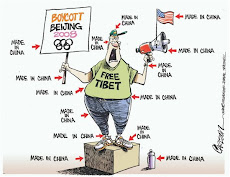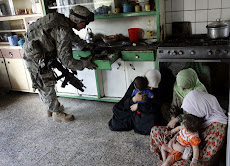
NY Times Jan. 20th. - When a girl is taken — usually by her mother — to a free circumcision event held each spring in Bandung, Indonesia, she is handed over to a small group of women who, swiftly and yet with apparent affection, cut off a small piece of her genitals. Sponsored by the Assalaam Foundation, an Islamic educational and social-services organization, circumcisions take place in a prayer center or an emptied-out elementary-school classroom where desks are pushed together and covered with sheets and a pillow to serve as makeshift beds. The procedure takes several minutes. There is little blood involved. Afterward, the girl’s genital area is swabbed with the antiseptic Betadine. She is then helped back into her underwear and returned to a waiting area, where she’s given a small, celebratory gift — some fruit or a donated piece of clothing — and offered a cup of milk for refreshment. She has now joined a quiet majority in Indonesia, where, according to a 2003 study by the Population Council, an international research group, 96 percent of families surveyed reported that their daughters had undergone some form of circumcision by the time they reached 14.
These photos were taken in April 2006, at the foundation’s annual mass circumcision, which is free and open to the public and held during the lunar month marking the birth of the prophet Muhammad. The Assalaam Foundation runs several schools and a mosque in Bandung, Indonesia’s third-largest city and the capital of West Java. The photographer Stephanie Sinclair was taken to the circumcision event by a reproductive-health observer from Jakarta and allowed to spend several hours there. Over the course of that Sunday morning, more than 200 girls were circumcised, many of them appearing to be under the age of 5. Meanwhile, in a nearby building, more than 100 boys underwent a traditional circumcision as well. According to Lukman Hakim, the foundation’s chairman of social services, there are three “benefits” to circumcising girls. “One, it will stabilize her libido,” he said through an interpreter. “Two, it will make a woman look more beautiful in the eyes of her husband. And three, it will balance her psychology.” Female genital cutting — commonly identified among international human rights groups as female genital mutilation — has been outlawed in 15 African countries. Many industrialized countries also have similar laws. Both France and the U.S. have prosecuted immigrant residents for performing female circumcisions.
In Indonesia, home to the world’s largest Muslim population, a debate over whether to ban female circumcision is in its early stages. The Ministry of Health has issued a decree forbidding medical personnel to practice it, but the decree which has yet to be backed by legislation does not affect traditional circumcisers and birth attendants, who are thought to do most female circumcisions. Many agree that a full ban is unlikely without strong support from the country’s religious leaders. According to the Population Council study, many Indonesians view circumcision for boys and girls as a religious duty. Female circumcision in Indonesia is reported to be less extreme than the kind practiced in other parts of the globe — Africa, particularly. Worldwide, female genital cutting affects up to 140 million women and girls in varying degrees of severity, according to estimates from the World Health Organisation. The most common form of female genital cutting, representing about 80 percent of cases around the world, includes the excision of the clitoris and the labia minora. A more extreme version of the practice, known as Pharaonic circumcision or infibulation, accounts for 15 percent of cases globally and involves the removal of all external genitalia and a stitching up of the vaginal opening.
Studies have shown that in some parts of Indonesia, female circumcision is more ritualistic — a rite of passage meant to purify the genitals and bestow gender identity on a female child — with a practitioner rubbing turmeric on the genitals or pricking the clitoris once with a needle to draw a symbolic drop of blood. In other instances, the procedure is more invasive, involving what WHO classifies as “Type I” female genital mutilation, defined as excision of the clitoral hood, called the prepuce, with or without incision of the clitoris itself. The Population Council’s 2003 study said that 82 percent of Indonesian mothers who witnessed their daughters’ circumcision reported that it involved “cutting.” The women most often identified the clitoris as the affected body part. The amount of flesh removed, if any, was alternately described by circumcisers as being the size of a quarter-grain of rice, a guava seed, a bean, the tip of a leaf, the head of a needle. At the Assalaam Foundation, traditional circumcisers say they learn the practice from other women during several years of apprenticing. Siti Rukasitta, who has been a circumciser at the foundation for 20 years, said through an interpreter that they use a small pair of sterilized scissors to cut a piece of the clitoral prepuce about the size of a nail clipping. Population Council observers who visited the event before the 2003 study, however, reported that they also witnessed some cases of circumcisers cutting the clitoris itself.
Any distinction between injuring the clitoris or the clitoral hood is irrelevant, says Laura Guarenti, an obstetrician and WHO’s medical officer for child and maternal health in Jakarta. “The fact is there is absolutely no medical value in circumcising girls,” she says. “It is 100 percent the wrong thing to be doing.” The circumcision of boys, she adds, has demonstrated health benefits, namely reduced risk of infection and some protection against H.I.V.
Nonetheless, as Western awareness of female genital cutting has grown, anthropologists, policy makers and health officials have warned against blindly judging those who practice it, saying that progress is best made by working with local leaders and opinion-makers to gradually shift the public discussion of female circumcision from what it’s believed to bestow upon a girl toward what it takes away. “These mothers believe they are doing something good for their children,” Guarenti, a native of Italy, told me. “For our culture that is not easily understandable. To judge them harshly is to isolate them. You cannot make change that way.”
By SARA CORBETT
+++++++++++++++++++++++++++++++++++++++++++++++++++
Disclaimer
No responsibility or liability shall attach itself to either myself or to the blogspot ‘Mozlink’ for any or all of the articles/images placed here. The placing of an article does not necessarily imply that I agree or accept the contents of the article as being necessarily factual in theology, dogma or otherwise.
Mozlink





















































No comments:
Post a Comment